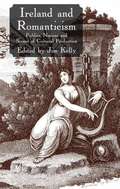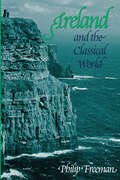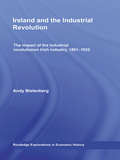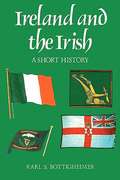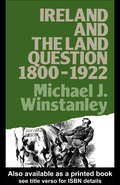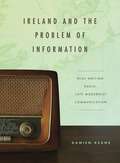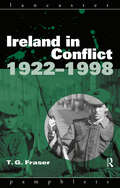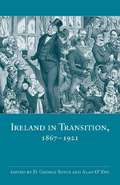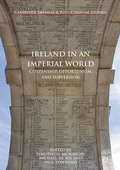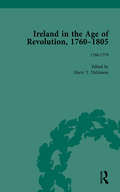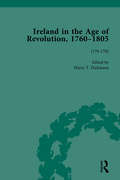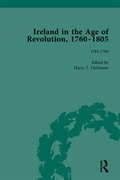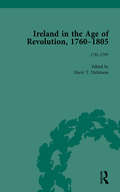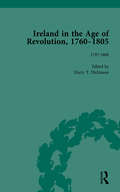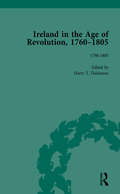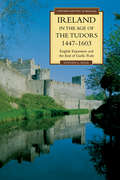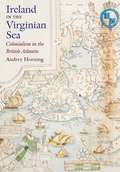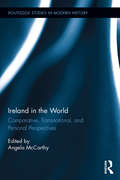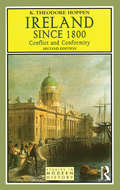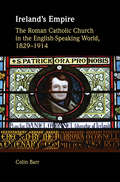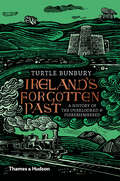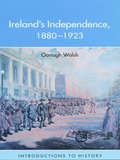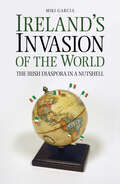- Table View
- List View
Ireland and Romanticism
by Jim KellyThis collection by leading scholars in the field provides a fascinating and ground-breaking introduction to current research in Irish Romantic studies. It proves the international scope and aesthetic appeal of Irish writing in this period, and shows the importance of Ireland to wider currents in Romanticism.
Ireland and the Classical World
by Philip FreemanOn the boundary of what the ancient Greeks and Romans considered the habitable world, Ireland was a land of myth and mystery in classical times.<P><P> Classical authors frequently portrayed its people as savages—even as cannibals and devotees of incest—and evinced occasional uncertainty as to the island's shape, size, and actual location. Unlike neighboring Britain, Ireland never knew Roman occupation, yet literary and archaeological evidence prove that Iuverna was more than simply terra incognita in classical antiquity. <P> In this book, Philip Freeman explores the relations between ancient Ireland and the classical world through a comprehensive survey of all Greek and Latin literary sources that mention Ireland. He analyzes passages (given in both the original language and English) from over thirty authors, including Julius Caesar, Strabo, Tacitus, Ptolemy, and St. Jerome. To amplify the literary sources, he also briefly reviews the archaeological and linguistic evidence for contact between Ireland and the Mediterranean world. <P> Freeman's analysis of all these sources reveals that Ireland was known to the Greeks and Romans for hundreds of years and that Mediterranean goods and even travelers found their way to Ireland, while the Irish at least occasionally visited, traded, and raided in Roman lands. Everyone interested in ancient Irish history or Classics, whether scholar or enthusiast, will learn much from this pioneering book.
Ireland and the Industrial Revolution: The impact of the industrial revolution on Irish industry, 1801-1922 (Routledge Explorations in Economic History)
by Andy BielenbergThis monograph provides the first comprehensive analysis of industrial development in Ireland and its impact on Irish society between 1801-1922. Studies of Irish industrial history to date have been regionally focused or industry specific. The book addresses this problem by bringing together the economic and social dimensions of Irish industrial history during the Union between Ireland and Great Britain. In this period, British economic and political influences on Ireland were all pervasive, particularly in the industrial sphere as a consequence of the British industrial revolution. By making the Irish industrial story more relevant to a wider national and international audience and by adopting a more multi-disciplinary approach which challenges many of the received wisdoms derived from narrow regional or single industry studies - this book will be of interest to economic historians across the globe as well as all those interested in Irish history more generally.
Ireland and the Irish in Interwar England
by Mo MoultonTo what extent did the Irish disappear from English politics, life and consciousness following the Anglo-Irish War? Mo Moulton offers a new perspective on this question through an analysis of the process by which Ireland and the Irish were redefined in English culture as a feature of personal life and civil society rather than a political threat. Considering the Irish as the first postcolonial minority, she argues that the Irish case demonstrates an English solution to the larger problem of the collapse of multi-ethnic empires in the twentieth century. Drawing on an array of new archival evidence, Moulton discusses the many varieties of Irishness present in England during the 1920s and 1930s, including working-class republicans, relocated southern loyalists, and Irish enthusiasts. The Irish connection was sometimes repressed, but it was never truly forgotten; this book recovers it in settings as diverse as literary societies, sabotage campaigns, drinking clubs, and demonstrations.
Ireland and the Irish: A Short History
by Karl S. BottigheimerThis book tells the story of Ireland as well as it can be told, on the basis of up-to-date research, within the limits of three hundred pages.
Ireland and the Land Question 1800-1922 (Lancaster Pamphlets)
by Michael J. WinstanleyThis pamphlet makes use of the most recent revisionist literature to reassess the view, much propagated by nationalist sources, that Ireland was a land of impoverished peasants oppressed by English laws and absentee English landlords.The land question has always been closely linked to the development of Irish national consciousness, and greatly exercised the minds of English politicians in the latter part of the nineteenth century. The author examines the nature of English understanding of Irish problems, which was often limited or ignorant, and attributes to it much of the unsound and ineffective ligislation passed. The book is concerned less with questions of English party politics than with the situation in Ireland itself and with the nature of the English response to it.
Ireland and the Problem of Information: Irish Writing, Radio, Late Modernist Communication (Refiguring Modernism #20)
by Damien KeaneThough the work of Irish writers has been paramount in conventional accounts of literary modernism, Ireland itself only rarely occupies a meaningful position in accounts of modernism’s historical trajectory. With an itinerary moving not simply among Dublin, Belfast, and London but also Paris, New York, Addis Ababa, Rome, Berlin, Geneva, and the world’s radio receivers, Ireland and the Problem of Information examines the pivotal mediations through which social knowledge was produced in the mid-twentieth century. Organized as a series of cross-fading case studies, the book argues that an expanded sphere of Irish cultural production should be read as much for what it indicates about practices of intermedial circulation and their consequences as for what it reveals about Irish writing around the time of the Second World War. In this way, it positions the “problem of information” as, first and foremost, an international predicament, but one with particular national implications for the Irish field.
Ireland and the Problem of Information: Irish Writing, Radio, Late Modernist Communication (Refiguring Modernism)
by Damien KeaneThough the work of Irish writers has been paramount in conventional accounts of literary modernism, Ireland itself only rarely occupies a meaningful position in accounts of modernism’s historical trajectory. With an itinerary moving not simply among Dublin, Belfast, and London but also Paris, New York, Addis Ababa, Rome, Berlin, Geneva, and the world’s radio receivers, Ireland and the Problem of Information examines the pivotal mediations through which social knowledge was produced in the mid-twentieth century. Organized as a series of cross-fading case studies, the book argues that an expanded sphere of Irish cultural production should be read as much for what it indicates about practices of intermedial circulation and their consequences as for what it reveals about Irish writing around the time of the Second World War. In this way, it positions the “problem of information” as, first and foremost, an international predicament, but one with particular national implications for the Irish field.
Ireland in Conflict 1922-1998 (Lancaster Pamphlets)
by T. G. FraserIreland in Conflict, 1922-1998 sets out the main political, economic and social developments in Ireland, north and south of the border, since the 1922 treaty. This book explains the troubles in their context and examines the underlying tensions which led to prolonged violence after a period of relative civil peace and rising prosperity. Ireland in Conflict discusses: * the Civil War, its legacy for Irish politics and the Boundary Commission* the IRA, Orange Order and the Unionist party* the role of the Catholic Church and the Protestant minority* escalation of violence in the 1970s including Bloody Sunday and the hunger strikes* the Anglo-Irish agreement, the cease-fire and the hope for a peaceful solution.
Ireland in Transition, 1867-1921
by Alan O’Day D. George BoyceThis wide-ranging collection brings together multiple perspectives on a key period in Irish history, from the Fenian Rising in 1867 to the creation of the Irish Free State and Northern Ireland in 1921, with a focus on the formation of Irish identity. The chapters, written by team of experts, focus on key individuals or ideological groups and consider how they perceived Ireland's future, what their sense of Irish identity was, and who they saw as the enemy. Providing a new angle on Ireland during the period from 1867 to 1921, this book will be important reading for all those with an interest in Irish history.
Ireland in an Imperial World
by Michael De Nie Timothy G. Mcmahon Paul TownendIreland in an Imperial World interrogates the myriad ways through which Irish men and women experienced, participated in, and challenged empires in the nineteenth and twentieth centuries. Most importantly, they were integral players simultaneously managing and undermining the British Empire, and through their diasporic communities, they built sophisticated arguments that aided challenges to other imperial projects. In emphasizing the interconnections between Ireland and the wider British and Irish worlds, this book argues that a greater appreciation of empire is essential for enriching our understanding of the development of Irish society at home. Moreover, these thirteen essays argue plainly that Ireland was on the cutting edge of broader global developments, both in configuring and dismantling Europe's overseas empires.
Ireland in the Age of Revolution, 1760–1805, Part I, Volume 1
by Harry T DickinsonThe latter half of the eighteenth-century saw Irish opposition movements being greatly influenced by the American and French revolutions. This two-part, six-volume edition illustrates the depth and reach of this influence by publishing pamphlets dealing with the major political issues of these decades.
Ireland in the Age of Revolution, 1760–1805, Part I, Volume 2
by Harry T DickinsonThe latter half of the eighteenth-century saw Irish opposition movements being greatly influenced by the American and French revolutions. This two-part, six-volume edition illustrates the depth and reach of this influence by publishing pamphlets dealing with the major political issues of these decades.
Ireland in the Age of Revolution, 1760–1805, Part I, Volume 3
by Harry T DickinsonThe latter half of the eighteenth-century saw Irish opposition movements being greatly influenced by the American and French revolutions. This two-part, six-volume edition illustrates the depth and reach of this influence by publishing pamphlets dealing with the major political issues of these decades.
Ireland in the Age of Revolution, 1760–1805, Part II, Volume 4
by Harry T DickinsonThe latter half of the eighteenth-century saw Irish opposition movements being greatly influenced by the American and French revolutions. This two-part, six-volume edition illustrates the depth and reach of this influence by publishing pamphlets dealing with the major political issues of these decades.
Ireland in the Age of Revolution, 1760–1805, Part II, Volume 5
by Harry T DickinsonThe latter half of the eighteenth-century saw Irish opposition movements being greatly influenced by the American and French revolutions. This two-part, six-volume edition illustrates the depth and reach of this influence by publishing pamphlets dealing with the major political issues of these decades.
Ireland in the Age of Revolution, 1760–1805, Part II, Volume 6
by Harry T DickinsonThe latter half of the eighteenth-century saw Irish opposition movements being greatly influenced by the American and French revolutions. This two-part, six-volume edition illustrates the depth and reach of this influence by publishing pamphlets dealing with the major political issues of these decades.
Ireland in the Age of the Tudors, 1447-1603: English Expansion and the End of Gaelic Rule (Longman History of Ireland)
by Steven G. EllisThe second edition of Steven Ellis's formidable work represents not only a survey, but also a critique of traditional perspectives on the making of modern Ireland. It explores Ireland both as a frontier society divided between English and Gaelic worlds, and also as a problem of government within the wider Tudor state. This edition includes two major new chapters: the first extending the coverage back a generation, to assess the impact on English Ireland of the crisis of lordship that accompanied the Lancastrian collapse in France and England; and the second greatly extending the material on the Gaelic response to Tudor expansion.
Ireland in the Virginian Sea
by Audrey HorningIn the late sixteenth century, the English started expanding westward, establishing control over parts of neighboring Ireland as well as exploring and later colonizing distant North America. Audrey Horning deftly examines the relationship between British colonization efforts in both locales, depicting their close interconnection as fields for colonial experimentation. Focusing on the Ulster Plantation in the north of Ireland and the Jamestown settlement in the Chesapeake, she challenges the notion that Ireland merely served as a testing ground for British expansion into North America. Horning instead analyzes the people, financial networks, and information that circulated through and connected English plantations on either side of the Atlantic. In addition, Horning explores English colonialism from the perspective of the Gaelic Irish and Algonquian societies and traces the political and material impact of contact. The focus on the material culture of both locales yields a textured specificity to the complex relationships between natives and newcomers while exposing the lack of a determining vision or organization in early English colonial projects.
Ireland in the World: Comparative, Transnational, and Personal Perspectives (Routledge Studies in Modern History #16)
by Angela McCarthyThis international edited book collection of ten original contributions from established and emerging scholars explores aspects of Ireland’s place in the world since the 1780s. It imaginatively blends comparative, transnational, and personal perspectives to examine migration in a range of diverse geographical locations including Ireland, Scotland, Wales, Australia, New Zealand, the United States, Canada, Argentina, Jamaica, and the British Empire more broadly. Deploying diverse sources including letters, interviews, press reports, convict records, and social media, contributors canvas important themes such as slavery, convicts, policing, landlordism, print culture, loyalism, nationalism, sectarianism, politics, and electronic media. A range of perspectives including Catholic and Protestant, men and women, convicts and settlers are included, and the volume is accompanied by a range of striking images.
Ireland since 1800: Conflict and Conformity (Studies In Modern History)
by K. Theodore HoppenThe second edition of this bestselling survey of modern Irish history covers social, religious as well as political history and offers a distinctive combination of chronological and thematic approaches.
Ireland's Empire: The Roman Catholic Church in the English-Speaking World, 1829–1914
by Colin BarrHow did the Irish stay Irish? Why are Irish and Catholic still so often synonymous in the English-speaking world? Ireland's Empire is the first book to examine the complex relationship between Irish migrants and Roman Catholicism in the nineteenth century on a truly global basis. Drawing on more than 100 archives on five continents, Colin Barr traces the spread of Irish Roman Catholicism across the English-speaking world and explains how the Catholic Church became the vehicle for Irish diasporic identity in the United States, Australia, Canada, South Africa, New Zealand, Newfoundland, and India between 1829 and 1914. The world these Irish Catholic bishops, priests, nuns, and laity created endured long into the twentieth century, and its legacy is still present today.
Ireland's Forgotten Past: A History Of The Overlooked And Disremembered
by Turtle BunburyThis volume delves into Ireland’s forgotten history bringing to light some of the most colorful characters and intriguing episodes of the country’s long history. Ireland is approximately the size of the state of Indiana, yet this small country boasts an extensive, rich, and fascinating history. Ireland’s Forgotten Past is an alternative history that covers 13,000 years in 36 stories that are often left out of history books. Among the characters in these absorbing accounts are a pair of ill- fated prehistoric chieftains, a psychopathic Viking, a gallant Norman knight, a dazzling English traitor, an ingenious tailor, an outstanding war-horse, a brothel queen, an insanely prolific sculptor, and a randy prince. This volume offers a succinct account of the Stone Age and Bronze Age, as well as insights into the Bell-Beakers, the Romans, and the Knights Templar. Historian Turtle Bunbury writes a gently off-beat take on monumental events like the Wars of the Roses, the Tudor Conquest and the Battle of the Boyne, as well as the Home Rule campaign and the Great War. Ireland’s Forgotten Past adds color to the existing histories of the country by focusing on the unique characters and intriguing events. This volume will delight anyone interested in the rich untold history of Ireland.
Ireland's Independence: 1880-1923 (Introductions To History Ser.)
by Oonagh WalshFirst published in 2004. Routledge is an imprint of Taylor & Francis, an informa company.
Ireland's Invasion of the World: The Irish Diaspora in a Nutshell
by Miki GarciaFor much of Ireland’s history her people have been emigrating and the Irish Diaspora today is estimated to be over 100 million people, many times larger than the current population of Ireland. For the most part they scattered not as colonizers but as migrants, they took their culture and identity with them and made a mark on their adopted county. They fought wars, formed societies, shaped cultures, created new identities and made history. This book looks at the Irish contribution to the story of all five continents, recalling unsung heroes, tragic tales and forgotten legacies.
